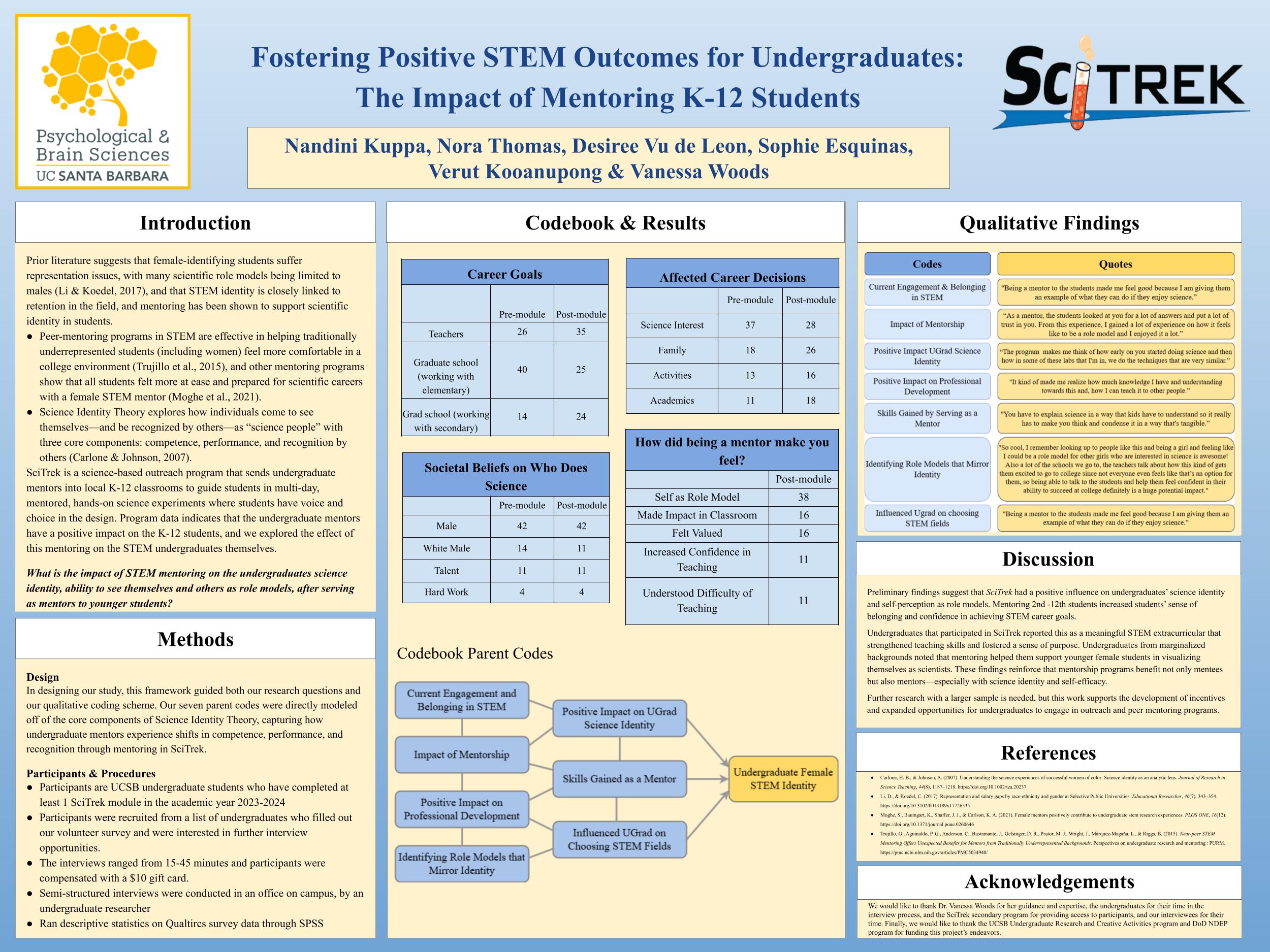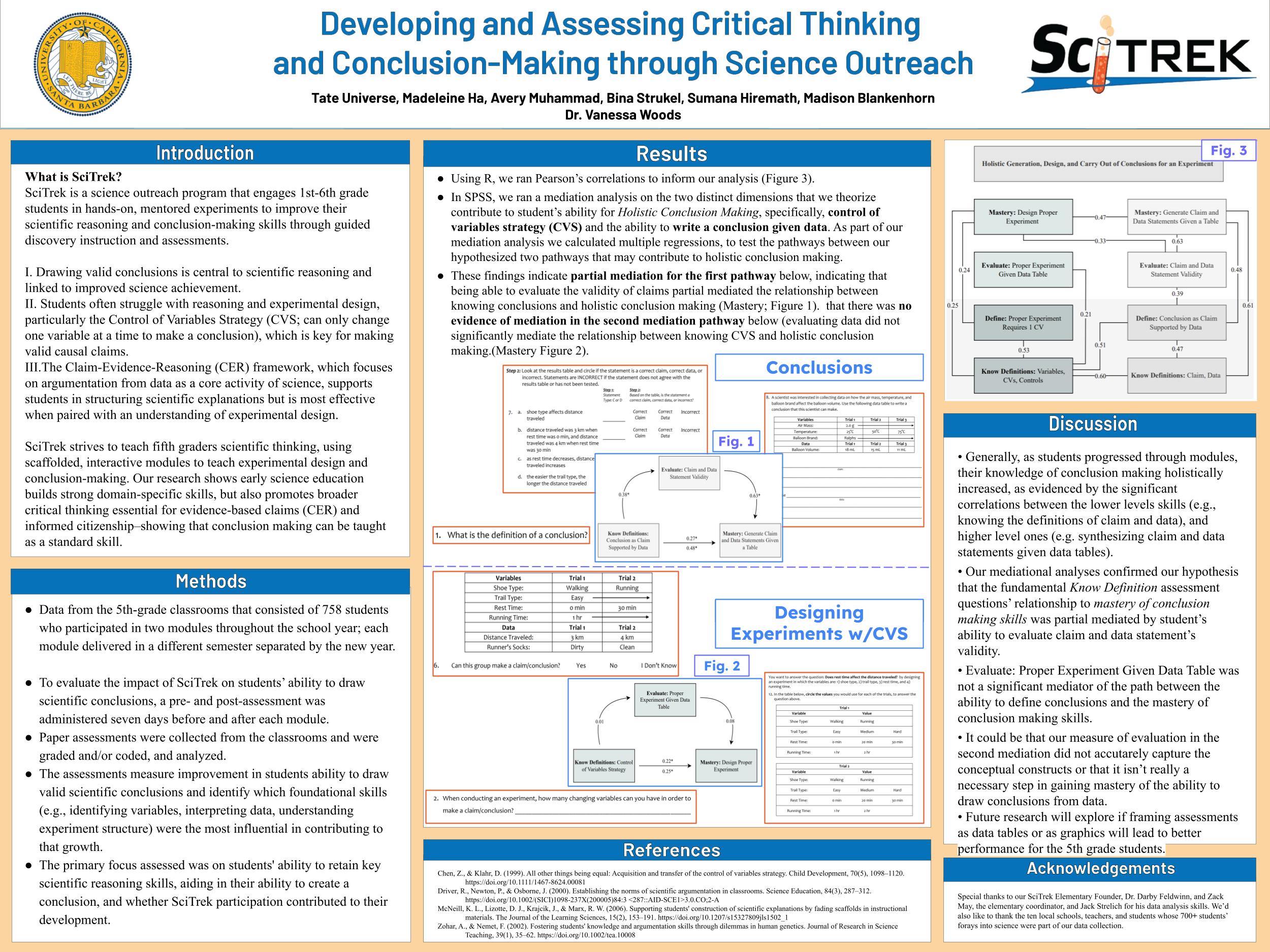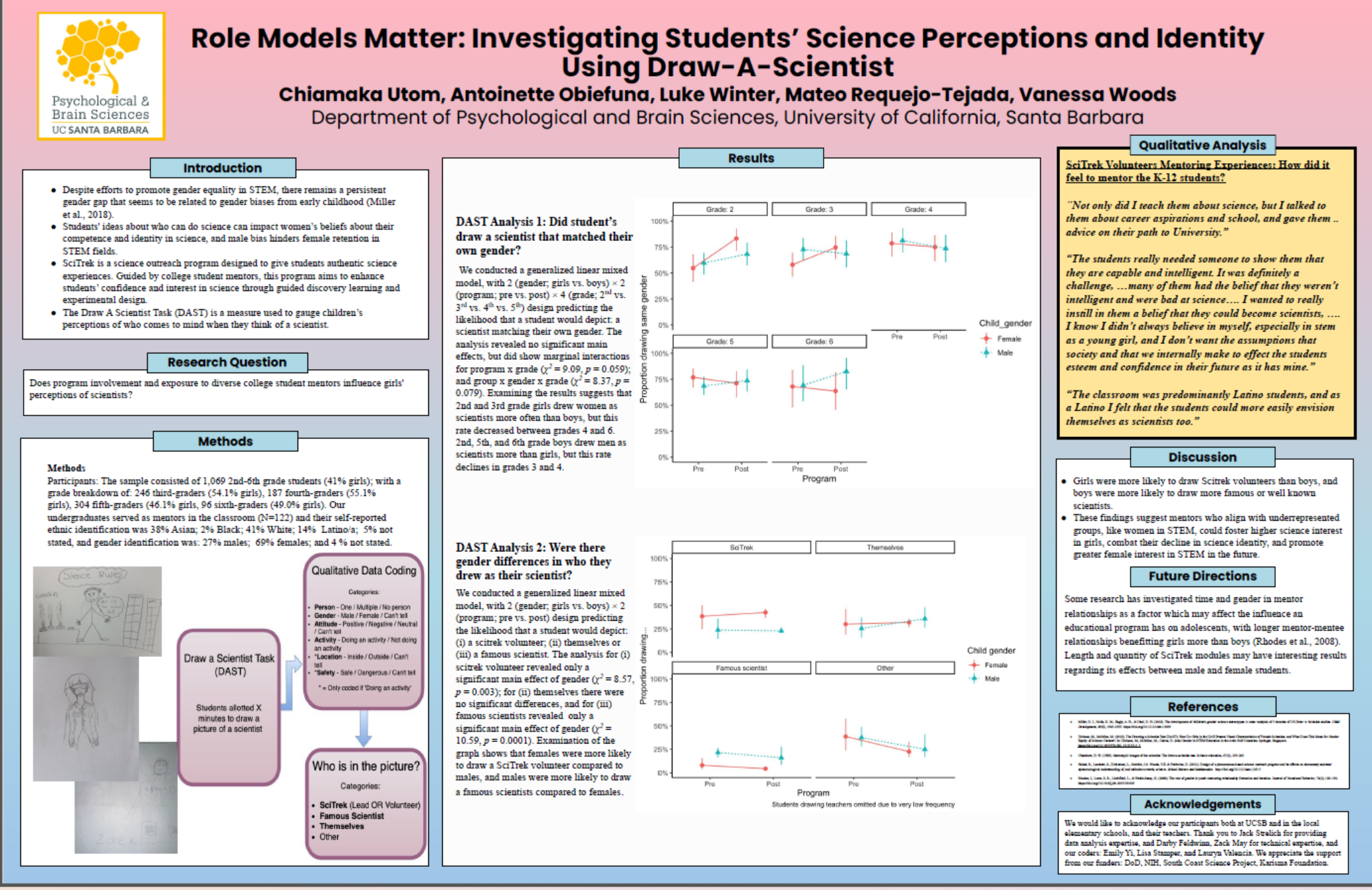PUBLICATIONS
Design of a phenomenon-based science outreach program and its effects on elementary students' epistemological understanding of, and attitudes towards science
Ryan T. Helsel, Sammi Lambert, Lindsey Dickerson, Jack Strelich, Vanessa Woods, Darby Feldwinn
Abstract:
This study describes the design and implementation of a science outreach program (elementary; 2nd–5th) and its associated student outcomes. Key features of the program include: (a) phenomenon-based, NGSS-aligned curriculum designed by science education experts and influenced by educational, sociocultural, and cognitive science theories, (b) active engagement by elementary students in experimentation and exploration of a common phenomenon (2 per year, called modules) across multiple sessions (6–8 per module), (c) professional development (PD) provided to scientists (mentors) and teachers to supply classrooms with multiple (5–7) adult more knowledgeable others (AMKOs), and (d) close classroom interaction between elementary students and mentors, allowing for students to participate in evidence-based sense-making through whole-class and small-group discussions. We examined the effect of program participation on students’ epistemological understanding of science (EUS) and attitudes toward science, as well as surveyed teachers to determine how they felt the program affected students’ attitudes and EUS. Student measures indicated they developed a deeper understanding of the process of scientific knowledge generation and were more likely to report liking science more than less. Similarly, teachers’ self-reports corroborated these results, as well as showed teachers thought the structure of the program effectively integrated mathematics and language arts.
The Efficacy of SciTrek in Solving the Transfer Problem and Supporting Teacher Enactment of the Next Generation Science Standards
Sarah Hough, Darby Feldwinn, and Vanessa Woods
Abstract
SciTrek provides an apprenticeship model of professional development to teachers as part of their phenomenon based science outreach program for 2nd-5th grade students. This model allows teachers to engage in professional development before activities happen in their classroom and then within a week enact what they have learned with their students. In addition to the community of practice we foster, SciTrek provides a real time expert there to provide support and coaching for the teacher in the classroom with their students. In this model it takes three years for a teacher to move from novice (watching an expert teach their class) to intermediate (co-teaching with an expert) to expert (teaching on their own and providing support to others). 92% of teachers in the study reported improvements in their understanding and/or confidence in teaching in one or more of the following: science content, Science and Engineering Practices (SEPs), or Next Generation Science Standards (NGSS). Teachers at every level (novice, intermediate, and expert) increased their knowledge, however, what they learned varied. Novices showed larger increases in NGSS understanding. Whereas experts showed larger increases in their confidence teaching NGSS. In addition, experts were more likely to engage in exploration where they incorporated what they learned into other non-SciTrek activities with teachers referencing using what they learned in other science lessons (e.g. writing procedures, use of vocabulary).
STUDENT POSTERS
2025
Fostering Positive STEM Outcomes for Undergraduates: The Impact of Mentoring K-12 StudentsNandini Kuppa, Nora Thomas, Desiree Vu de Leon, Sophie Esquinas, Verut Kooanupong and Vanessa Woods Retention of female undergraduate students in STEM is crucial for fostering innovation, equity, and a broader societal impact. However, prior literature suggests that female-identifying students suffer representation issues, with many scientific role models being limited to males (Li & Koedel, 2017). Previous literature shows that STEM identity is closely linked to retention in the field, and mentoring has been shown to support scientific identity in students. Previous research illustrates that peer-mentoring programs in STEM are effective in helping traditionally underrepresented students (including women) feel more comfortable in a college environment (Trujillo et al., 2015). Other mentoring programs show that all students felt more at ease and prepared for scientific careers with a female STEM mentor (Moghe et al., 2021). Though prior studies focus on the effects mentoring has on mentees, few studies explore the impact of STEM mentoring on the undergraduates serving as mentors to younger students. SciTrek is a science-based outreach program that sends undergraduate mentors into local K-12 classrooms to guide students in multi-day, mentored, hands-on science experiments where students have voice and choice in the design. Program data indicates that the undergraduate mentors have a positive impact on the K-12 students, and we explored the effect of this mentoring on the STEM undergraduates. We predict that serving as a mentor has the potential to positively impact undergraduates’ science identity, STEM career interest, and confidence in teaching science. To explore this hypothesis, we have qualitatively coded an existing data set of undergraduate volunteer pre- and post-program participation surveys in AY 2023-24, and through qualitative analysis of semi-structured interviews. Preliminary analysis of a small sample suggests that the undergraduate mentors are positively impacted by their mentoring experiences, and women often mentioned the importance of serving as a role model. We would like to explore this finding in a larger data set, and with in-depth interviews. Such data has the potential to provide evidence-based practices that can increase retention of women in STEM fields. |
Image

|
2025
Developing and Assessing Critical Thinking and Conclusion-Making through Science OutreachTate Universe, Madeleine Ha, Avery Muhammed, Sumana Hiremath, Madison Blankenhorn, and Vanessa Woods Scientific literacy, a crucial competency for engaging with and interpreting scientific information effectively. Understanding how to interpret scientific information is a domain-specific skill which is linked to the domain-general critical thinking skill (Viera et al., 2011). Evidence-based research surrounding critical thinking skills in primary schools reveals instructional activities scaffolding as an essential pedagogical approach for fostering critical thinking in elementary students. Making valid conclusions from data is a specific and actionable way to increase scientific literacy that can be further explored as a hierarchy of skills. Foundational to conclusion-making is the ability to apply Control of Variables Strategy (CVS); understanding you can only change one variable at a time for valid conclusion-making. Previous research has suggested that conclusion-making is typically introduced in middle school, however our educational outreach program, SciTrek, has a 5th grade curriculum that successfully fosters scientific inquiry and conclusion-making skills in students before middle school. We seek to validate a hierarchy of learning components which underlie conclusion-making, through an assessment series assigned to fifth graders. SciTrek delivers engaging, cooperative activities that are multi-day, mentored, hands-on science experiments where students have voice and choice in the design. Specifically, we investigate if student performance in conclusion-making improves as a result of taking part in the SciTrek modules, and use path analysis of students’ assessments to distinguish foundational skills (e.g. differentiating claims from data), that should contribute to the students’ abilities to identify and design valid conclusion parameters from various representations of data. Additionally, we hypothesize pictorial representations of experimental designs may enhance accessibility and comprehension for students who face challenges with text-heavy formats, being tables containing numerical and textual data without accompanying graphics. For the 2023-2024 school year, SciTrek has performed modules with 5 schools in Santa Barbara county, in 9 classrooms collecting data on roughly 530 students. We will present results of our path analysis to inform best practices for scaffolding conclusion-making ability and underscore SciTrek's impact in enhancing scientific reasoning skills, providing actionable results for refining instructional strategies within the classroom. |
Image

|
|
2024 Role Models Matter: Investigating Students' Science Perceptions and Identity Using Draw-A-ScientistChiamaka Utom, Antoinette Obiefuna, Luke Winter, Mateo Requejo-Tejada, and Vanessa Woods Despite efforts to promote gender equality in STEM, there remains a persistent gender gap that seems to be related to gender biases from early childhood. Students' ideas about who can do science can impact women’s beliefs about their competence and identity in science, and male bias hinders female retention in STEM fields. SciTrek is a science outreach program designed to give students authentic science experiences. Guided by college students mentors, this program aims to enhance student’s confidence and interest in science through guided discovery learning and experimental design. The Draw A Scientist Task (DAST) is a measure used to gauge childrens’ perceptions of who comes to mind when they think of a scientist. Using the DAST as a measure, we investigated if SciTrek’s use of diverse college student mentors might have an influence on girls’ perceptions of scientists. For this study, we ran a mixed linear model analysis on a coded data set of students’ perceptions of scientists on 2nd through 6th grade boys and girls. In the 2021 data set, we asked the students to write who their scientist was after they finished the drawing. Results revealed that girls were more likely to draw SciTrek volunteers (college student mentors) than boys, and boys were more likely to draw famous scientists than girls. Prior research suggests girls tend to draw fewer scientists than boys in early elementary school, and boys tend to draw men as scientists at all stages of elementary school, which increases with age (Miller et al., 2018). Our results were inconsistent with this finding, as 2nd and 3rd grade girls drew women as scientists more often than boys, but this rate decreased between grades 4 and 6. 2nd, 5th, and 6th grade boys drew men as scientists more than girls, but this rate declines in grades 3 and 4. These findings suggest mentors who align with underrepresented groups, like women in STEM, could foster higher science interest in girls, combat their decline in science identity, and promote greater female interest in STEM in the future. |
Image

|